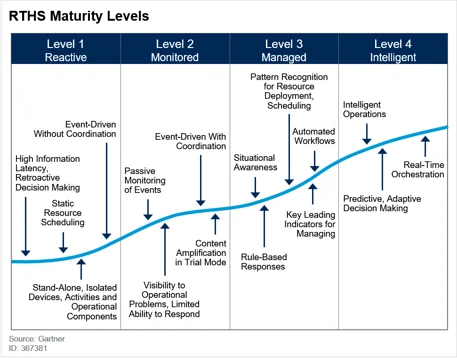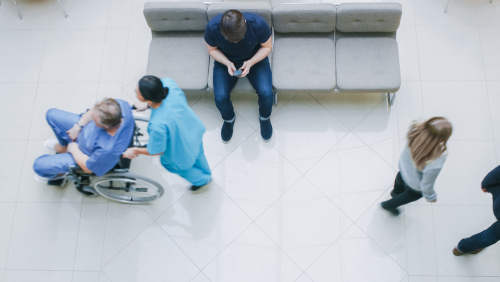THE REAL TIME HEALTH SYSTEM MODEL HELPS HEALTHCARE PROVIDERS UNDERSTAND THEIR CURRENT ABILITY TO RESPOND TO CHANGE IN THE MOMENT AND IDENTIFY WAYS TO IMPROVE.
As we emerge from the pandemic, US hospitals continue to struggle. According to a survey by KaufmaHall, more than half of hospitals expected negative operating margins in 2022. This is causing healthcare delivery organizations (HDOs) to consider digitization as a stepwise approach to efficient and effective care.
One of the core values of digitization is unlocking islands of locked information and sharing that across the enterprise. This creates an opportunity to optimize resources, reduce waste, and focus resources on high-value care delivery. HDOs are evaluating where along the digitization pathway they are today, and what is needed to advance.
One promise of digitization is improved collaboration among the resources that come together to improve patient throughput and capacity management. According to Barry Runyon of Gartner, HDOs should leverage patient throughput and capacity management to increase operational efficiency and digital innovation.[1] Gartner uses a maturity model to help HDOs evaluate their current position along the real time health system spectrum and how to progress toward higher states. “The RTHS is an operational, management and technology paradigm for the next-generation HDO — one that acquires and acts on real-time operational intelligence to achieve its business objectives. The RTHS transforms the HDO from a disjointed and reactive enterprise to one that is more efficient, collaborative and predictive.”

The ability to respond in the moment is at the heart of real time location systems like AiRISTA’s. An RTLS platform provides insight to the location and movement of people and equipment in a dynamic environment. An RTLS platform is foundational to all points along the Gartner maturity model.
Level 1, Reactive
To adjust in the moment, an RTLS platform will help clinicians find the nearest resource when a pump, bladder scanner or ultrasound device is needed. By some estimates, a nurse wastes 20 minutes per shift searching for equipment.
Level 2, Monitored
Level 2 improves on level 1 with visibility to problems to provide early indications and avoid a reactive surprise. Automated par level accounting of equipment will alert when equipment levels drop below a threshold or rise above an upper limit. RTLS platforms allow the user to create zones and monitor devices as they enter and leave zones. At level 2 clinical engineering knows where its equipment is located at all times and can round up devices for maintenance without a massive search of the facility.
Level 3, Managed
Process automation helps coordinate resources to create a smooth and managed response. AiRISTA’s Rule Composer allows users to create custom alerts in response to equipment movement, patient flows, and duress events. With the push of a tag’s button, clinical engineering can be alerted to the location of equipment that requires repair.
Level 4, Intelligent
Real time orchestration is where AiRISTA’s sofia RTLS software platform coordinates location information with existing applications to coordinate complex process and increase the ROI of your existing IT investments. AiRISTA’s Flow Studio is a drag & drop design low-code design environment to create more sophisticated workflows and integrations to 3rd party systems. For example, a patient discharge record can be combined with button pushes on a room tag to orchestrate efficient room cleaning and improve patient throughput.

Real time location systems, like AiRISTA’s, are a foundational component of any RTHS model. Sharing location insights across the enterprise help HDOs respond in a coordinated fashion to ever changing conditions in the facility. Combining location information with platforms like EHR, HR, Asset Management, and Control Centers allows HDOs to be more aware and therefore more proactive. The result is better capacity management using existing IT investments and ultimately better patient outcomes.
[1] “Put Patient Throughput and Capacity Management at the Center of Your Performance Improvement Plan”, Barry Runyon, Gartner, January 2021





